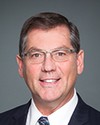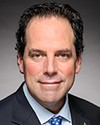Good morning, Mr. Chair and members of the committee, ladies and gentlemen. Thank you so much for inviting me and my colleague to speak with you today.
I am joined here by my colleague, Deputy Commissioner Brian Brennan, who is in charge of our contract and indigenous policing at the RCMP. We're here to provide you with information and respond to your questions.
At the outset, I would like to thank the Office of the Auditor General for its report and to highlight that the report is fully aligned with our vision 150, the RCMP's road map to modernization. The RCMP will turn 150 years old—or maybe 150 years young—in 2023, and since I have had the honour of taking the job as the commissioner of the RCMP, I have begun to implement vision 150.
To do this, we sought the input of all RCMP employees to build our modernization road map, which focuses on objectives that fall under the four key pillars: our people, our culture, our stewardship and our policing services. These four pillars have clear objectives that will steer us along the path forward in modernizing our organization.
Since the Moncton shootings in 2014, the RCMP has worked diligently to implement recommendations from the MacNeil report. The safety of our employees is of utmost importance to me as the commissioner and to the RCMP as a whole. A safe workplace is critical to the RCMP's ability to achieve its mandate of a safer Canada.
Accordingly, we have accepted each of the OAG's recommendations and are actively addressing and implementing them. The OAG highlighted that we met and exceeded our carbine training target and that we are also meeting our target of providing access to hard body armour to operational front-line officers.
I will take this opportunity to emphasize additional work that has been done, and is ongoing, which has also had a positive effect on officer safety.
Effective responses to active shooter incidences require not only the right equipment, but also the right training and the right tactics. Therefore, any analysis of our members' readiness must take into account the tactical training.
Since 2016, more than 13,000 officers have been trained in tactics to respond to active threats, and now all cadets at our training centre receive patrol carbine and active threat training. As a result, an average of 25 newly trained members are deployed across the country each week. Recently, the Government of Canada has invested a significant amount of money for a new state-of-the-art 100-metre range and simulation centre that will assist us in achieving these goals.
We have also trained more than 1,100 police officers in initial critical incident response, which educates supervisors on how to manage critical incidents until an accredited critical incident commander can take charge. There have been numerous incidents across the country where this training and equipment have saved lives.
Tactical training for RCMP officers has further supplemented other developments covered by the OAG's audit, particularly in relation to equipment and corresponding training. I am proud of how we continue to adapt and deliver leading-edge policing services that help keep communities safe. The RCMP has taken great strides in support of policing excellence and recognizes there are always opportunities for continuous and ongoing improvement.
Several activities are already under way to address concerns raised by the OAG. Last October we started using an electronic interactive mapping system that provides operational leaders in RCMP divisions with the number of carbines and carbine-trained officers down to the detachment level. This system supports evidence-based decision-making on carbine distribution.
The OAG found that we largely met our requirements for providing hard body armour. To continue looking forward for policing excellence, the RCMP is examining having hard body armour personally assigned to all operational front-line officers.
We are also developing a stronger operational standard for the number of carbine-trained members, and are examining the possibility of equipping every operational police vehicle with a long gun.
With respect to firearms training, we have far more consistency and have made significant improvements in a number of key areas. For example, the annual firearms qualification program was recently revised to focus on skills development and further enhance tactical training. We continue to improve our firearms instructor training to focus on physical skills and increasing compliance rates through the creation of a more facilitative learning environment for our officers.
Regarding our compliance levels for pistol and carbine annual qualifications, we recognize the importance of ensuring a ready workforce. That is why we are reviewing existing firearms training policies and practices, while also putting additional mechanisms in place to achieve the highest level of oversight and accountability. This work will be carried out under the guidance of the RCMP's national mandatory training oversight committee.
The RCMP will always strive towards the desired compliance rates and will work towards solutions for the challenges to be overcome, such as those that come with Canada's geography and climate, particularly in the north. My senior executive team and I will continue to hold ourselves to the high standards and are committed to supporting the review of existing firearms training policies and practices in order to achieve the highest level of compliance and accountability.
With regard to firearms maintenance, the RCMP has a well-established preventive maintenance program that seeks to ensure that all members have safe and reliable firearms for use in their duties, as well as spares when required. We are meeting this objective, and in response to the audit, we will ensure that our current preventative maintenance policies are clarified so that the expected periods of time for servicing are clearly articulated and communicated.
Last, the RCMP is committed to examining options for more robust project management and will ensure that life-cycle elements are considered during the project approval process. From a governance perspective, the RCMP will establish a committee for assets and materiel as part of its investment management framework to ensure investment decisions fully consider life cycles of given policing equipment.
It should also be noted that the RCMP has improved its oversight on officer safety equipment through the creation of an operational equipment oversight committee that ensures the timely advancement of procurement, training, and health and safety components for priority equipment. The RCMP is committed to an open, fair and transparent procurement process, while obtaining the best possible value for Canadians.
Before I conclude, I would stress that the RCMP is fiercely dedicated to taking care of our people, a key element of the RCMP's vision 150. Our road to modernization is a constant process. We understand that we will continue to face challenges and criticisms along the way and we will continue to come out as a stronger organization.
As we continue to work on the implementation of operational training and equipment, the OAG's recommendations will certainly assist us in our efforts and I'm confident that we will continue to improve. The RCMP has developed a management action plan to address all of the recommendations and will be sharing it with our membership as part of our culture of communicating decisions and holding ourselves to account.
Through stewardship and sound decision-making, we will ensure RCMP officers have access to the equipment and training they need to do their job as safely and effectively as possible.
We would be happy to respond to your questions. Thank you.










